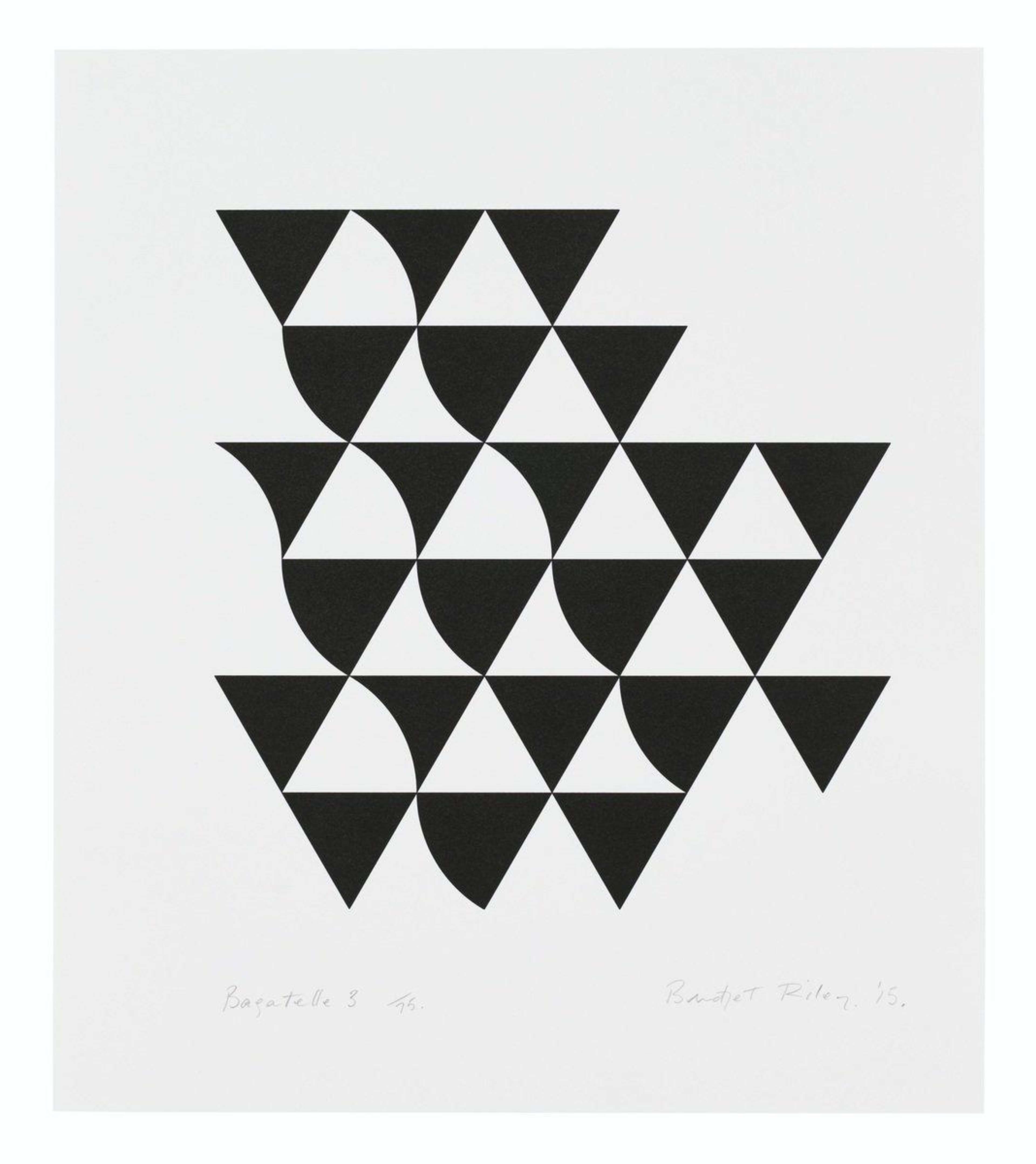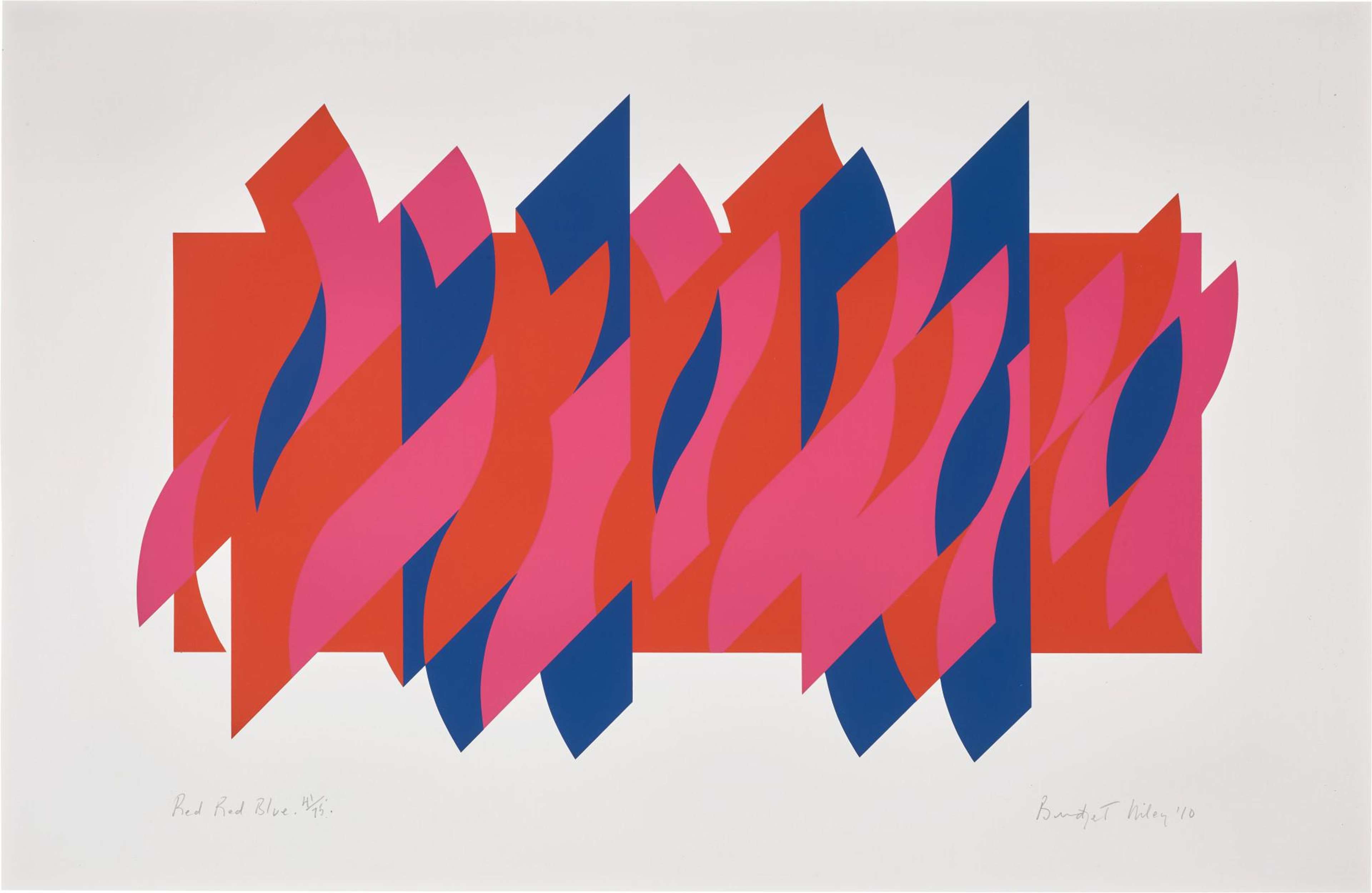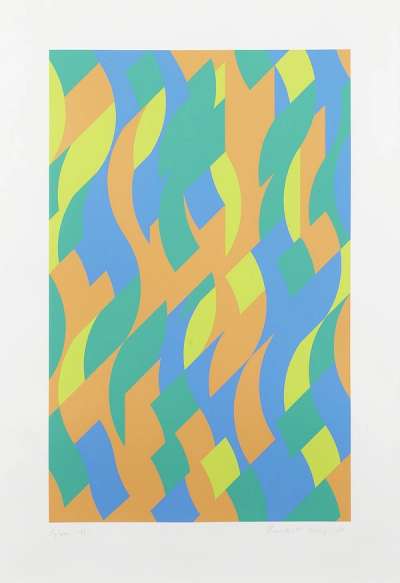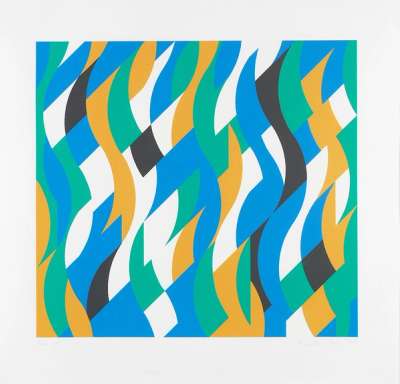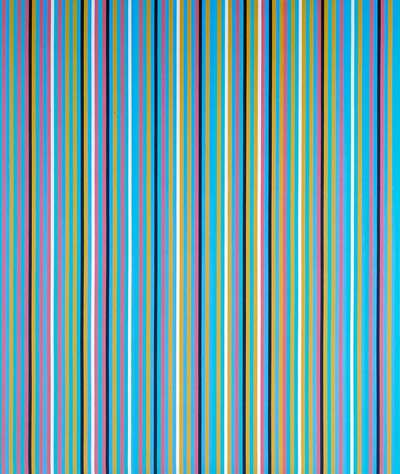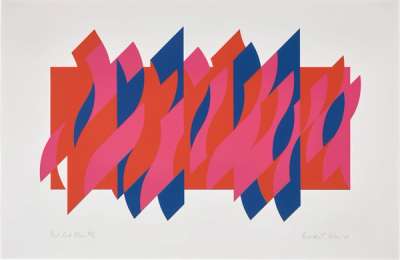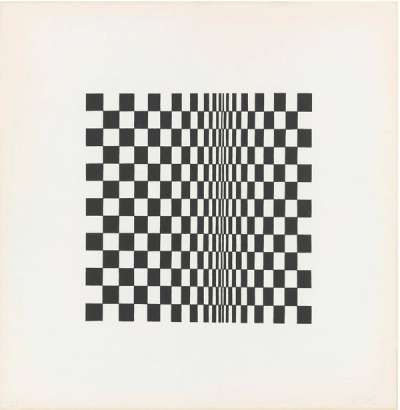 Achæan © Bridget Riley 1981
Achæan © Bridget Riley 1981
Bridget Riley
111 works
Bridget Riley has etched her name into the annals of art history as a pioneering force behind the Op Art movement. Born in London in 1931, Riley's artistic journey has been characterised by a relentless pursuit of understanding and manipulating visual perception through art. Her groundbreaking work, distinguished by its dynamic patterns, vibrant colours, and optical illusions, challenges viewers' perceptions and evokes a sense of movement and depth. This distinctive approach not only catapulted Riley to international acclaim but also significantly contributed to the Op Art movement's prominence in the 1960s and beyond.
Bridget Riley's Science of Seeing
Riley’s approach to Op Art, a term that emerged in the mid-1960s to describe art forms exploring optical illusions, was both scientific and exploratory. Riley's work investigates the dynamics of visual perception, creating vibrant, moving patterns that seem to pulse and flicker, challenging the viewer’s sight and mind. This scientific underpinning in her methodology allowed Riley to not just paint pictures but to sculpt experiences, manipulating light and form to engage the viewer's perceptual processes.
Among her most significant inspirations was Georges Seurat, whose pioneering technique of pointillism and sophisticated use of colour theory profoundly impacted Riley's early explorations, especially evident in works like Fragment 1. Seurat's methodical placement of dots and his analytical approach to colour harmonies resonated with Riley, informing her initial foray into the black and white visual language that would define her early phase.
The geometric precision and abstraction that Piet Mondrian and the Bauhaus movement exemplified profoundly influenced Bridget Riley's artistic evolution. Their focus on primary colours, basic shapes, and the dynamic between form and space guided Riley in creating intricate visual narratives. This approach orchestrates a complex interplay of perception, challenging and captivating the viewer. Riley's engagement with technological tools, like projectors for drafting her initial designs, along with her collaborative ventures with engineers and printmakers for expansive installations, highlights her forward-thinking methods.
Riley's intrigue with optical illusions and the processes of vision – how our brains synthesise visual information into a unified whole instead of isolated parts – echoes the psychological investigations into sight by scholars such as Hermann von Helmholtz. This blend of scientific inquisitiveness and artistic creativity propelled her to use repetition and patterning strategically, generating visual effects that appear to flutter and transform. This not only invites the audience into an interactive experience with the art but also underscores Riley's dedication to exploring the boundaries of visual perception.
The Responsive Eye: A Landmark Exhibition
The Responsive Eye, a landmark exhibition held at the Museum of Modern Art (MoMA) in New York in 1965, marked a seminal moment in the history of Op Art, catapulting the movement into the limelight of the American art scene. Riley's inclusion in this exhibition highlighted her pivotal role in shaping the Op Art movement, as a leading figure whose work was at the forefront of exploring visual perception through art. The exhibition showcased Riley's intricate, visually stimulating pieces like Current alongside works by Victor Vasarely and Joseph Albers, collectively emphasising the movement's focus on creating optical sensations of movement and colour through static images.
The exhibition's widespread media coverage and public interest propelled Op Art, and Riley's work, in particular, into the spotlight, fostering a new appreciation for the way art could engage with and alter visual perception. The Responsive Eye played a crucial role in popularising Op Art across America, establishing Riley as a central figure whose contributions were instrumental in defining the aesthetic and conceptual boundaries of the movement.
Bridget Riley at the Venice Biennale
In 1968, Bridget Riley emerged as a beacon of British art on the international stage during the Venice Biennale, an event renowned for showcasing avant-garde artists and movements from across the globe. Selected to represent Britain, Riley's participation in this prestigious exhibition marked a significant milestone in her career, catapulting her into the global limelight. Her presentation, a striking ensemble of geometric patterns and optical illusions, not only captured the essence of the burgeoning Op Art movement but also set a new benchmark for visual experimentation.
It was this innovative approach that earned her the International Prize for painting at the Biennale, a distinction that was both an affirmation of her talent and a testament to her contribution to contemporary art. This accolade was not just a personal victory for Riley but a moment of national pride, as it underscored Britain's role in the evolution of modern art.
Bridget Riley’s Retrospectives and Major Solo Exhibitions
Serpentine Gallery
The 1971 retrospective at London's Serpentine Gallery emerged as a defining moment in Riley's career. This exhibition was among the first to offer a comprehensive look at Riley's oeuvre, tracing her journey from her early forays into dynamic black and white contrasts to her increasingly complex explorations into colour interactions. This exhibition was pivotal, not just for the audience's engagement with her work but for Riley's own understanding of her artistic trajectory. It showcased her mastery in creating visual experiences that transcend the simple act of viewing, inviting the audience into a participatory space of perception and illusion.
Tate Britain
Fast forward to 2003, and Tate Britain's major retrospective presented an even more comprehensive exploration of Riley's work. This exhibition was a reflective continuum of her evolving practice, spanning several decades of relentless experimentation. Highlighting her shift from monochrome to vibrant colour, the Tate retrospective underscored Riley's unique ability to constantly push the boundaries of visual perception. It was here that the full spectrum of Riley's artistic inquiry – from the impact of light and colour on human perception to the dynamic interplay between form and space – was meticulously laid out, offering insights into her methodical approach and the intellectual rigour behind her visually compelling compositions.
Hayward Gallery
The Hayward Gallery's 2019 retrospective on Bridget Riley, developed in collaboration with the artist and the National Galleries of Scotland, is the most comprehensive exhibition of her work to date. Spanning seven decades, it showcases her evolution from iconic black-and-white paintings of the 1960s to expansive colour canvases and recent wall paintings. The exhibition uniquely includes Continuum, Riley's only three-dimensional work, alongside rare drawings and studies revealing her creative process from 1947 to the present. This retrospective offers an unparalleled opportunity to experience the work of one of the most significant contemporary artists, emphasising her pioneering role in visual art.
Museum of Modern Art Paris
Bridget Riley's first Paris retrospective at the Museum of Modern Art highlights her career evolution, from 1950s landscape drawings to recent abstracts and a wall painting honouring Matisse's La Danse. This 14th global showcase since 1971 features her journey through Op Art fame to large-scale, vividly coloured abstracts. It includes early Seurat-inspired works, iconic black and white paintings, and recent vibrant canvases. The exhibition, enriched with over sixty paintings and eighty drawings, demonstrates Riley's continuous creative evolution. Accompanied by a bilingual catalogue with essays and interviews, this 2008 exhibition underscores Riley's global influence on modern art, celebrating her innovative contributions.
Bridget Riley’s Stripe Paintings
Riley's oeuvre is a testament to her enduring fascination and experimentation with the dynamics of colour theory and optical perception. Through her innovative use of stripes, Riley not only applies colour theory but actively delves into its exploration, pushing the boundaries of how colour and form interact to conjure vibrant, pulsating visual effects.
Her meticulous approach to composition, leveraging the Bezold Effect, reveals the transformative power of adjacent hues to alter the perception of colour itself. Works like Edge Of Light exemplify this exploration, where vertical stripes pulsate with a life of their own, creating a rhythmic interplay of hues that seem to vibrate off the canvas. Similarly, Firebird embarks on a chromatic odyssey, weaving vertical stripes in a mesmerising dance that generates a dynamic, twisting visual illusion, again showcasing Riley’s mastery in manipulating the viewer's perception through strategic colour and line placement.
The Impact of Bridget Riley's Work
Riley's career, spanning over six decades, is a testament to her unwavering commitment to exploration and innovation. From her initial foray into black-and-white geometric patterns to her later experiments with color and form, Riley's oeuvre reflects a deep engagement with the principles of vision and the interaction between color and shape. Her contributions have not only enriched the visual arts landscape but have also bridged the gap between art and science, drawing on research in perception to create compelling, engaging works that invite viewers to see the world anew.
The impact of Bridget Riley's work extends far beyond the confines of the Op Art movement. Through her extensive body of work, numerous exhibitions, and public commissions, Riley has influenced generations of artists, designers, and thinkers. Her legacy, marked by prestigious awards and accolades, including the International Prize for painting at the Venice Biennale in 1968, underscores her role as a key figure in contemporary art. Riley remains a beacon of innovation, her work a continual source of inspiration and fascination, inviting us to explore the limitless possibilities of visual perception.









